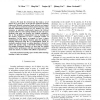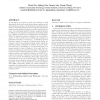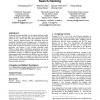131 search results - page 2 / 27 » Pairwise Preference Learning and Ranking |
COLING
2010
12 years 12 months ago
2010
Machine-learned ranking techniques automatically learn a complex document ranking function given training data. These techniques have demonstrated the effectiveness and flexibilit...
ICDM
2010
IEEE
13 years 2 months ago
2010
IEEE
We study the retrieval task that ranks a set of objects for a given query in the pairwise preference learning framework. Recently researchers found out that raw features (e.g. word...
ICML
2006
IEEE
14 years 5 months ago
2006
IEEE
Most work on preference learning has focused on pairwise preferences or rankings over individual items. In this paper, we present a method for learning preferences over sets of it...
SIGIR
2012
ACM
11 years 7 months ago
2012
ACM
In this paper, we propose a novel top-k learning to rank framework, which involves labeling strategy, ranking model and evaluation measure. The motivation comes from the difficul...
CIKM
2009
Springer
13 years 11 months ago
2009
Springer
Traditional boosting algorithms for the ranking problems usually employ the pairwise approach and convert the document rating preference into a binary-value label, like RankBoost....



